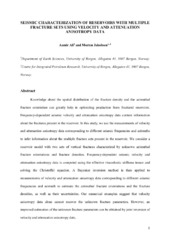Seismic characterization of reservoirs with multiple fracture sets using velocity and attenuation anisotropy data
Journal article
Submitted version
Permanent lenke
https://hdl.handle.net/1956/5032Utgivelsesdato
2011Metadata
Vis full innførselSamlinger
- Department of Earth Science [1050]
Originalversjon
10.1016/j.jappgeo.2011.09.003Sammendrag
Knowledge about the spatial distribution of the fracture density and the azimuthal fracture orientation can greatly help in optimizing production from fractured reservoirs. Frequency-dependent seismic velocity and attenuation anisotropy data contain information about the fractures present in the reservoir. In this study, we use the measurements of velocity and attenuation anisotropy data corresponding to different seismic frequencies and azimuths to infer information about the multiple fracture sets present in the reservoir. We consider a reservoir model with two sets of vertical fractures characterized by unknown azimuthal fracture orientations and fracture densities. Frequency-dependent seismic velocity and attenuation anisotropy data is computed using the effective viscoelastic stiffness tensor and solving the Christoffel equation. A Bayesian inversion method is then applied to measurements of velocity and attenuation anisotropy data corresponding to different seismic frequencies and azimuth to estimate the azimuthal fracture orientations and the fracture densities, as well as their uncertainties. Our numerical examples suggest that velocity anisotropy data alone cannot recover the unknown fracture parameters. However, an improved estimation of the unknown fracture parameters can be obtained by joint inversion of velocity and attenuation anisotropy data.
